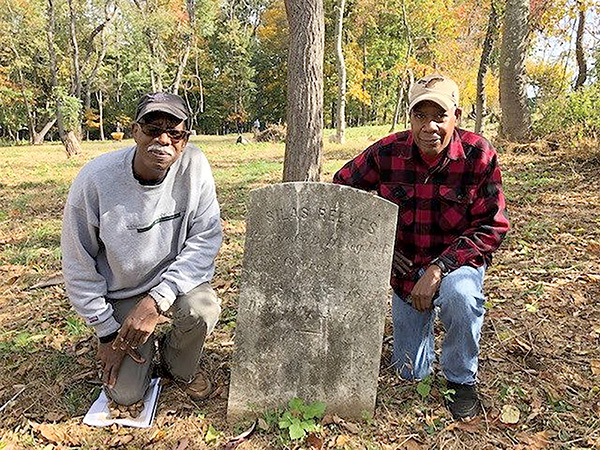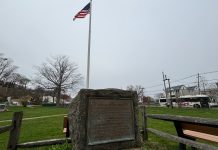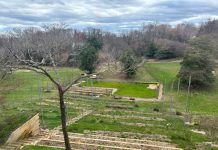
By Gloria Stravelli
LINCROFT – Once overgrown with thicket, a restored local cemetery will be the setting Memorial Day for a patriotic tribute to an overlooked group of soldiers laid to rest in an African American burial ground.
Friends of Cedar View, a group dedicated to restoring the circa 1850 graveyard, invites all to Cedar View Cemetery on Hurley’s Lane in Lincroft Monday, May 31, for a service to honor 10 African American veterans who served during the Civil War.
“Memorial Day is a reflective time set aside to honor our veterans who served this country to protect our freedom. Those veterans who are interred at this historical site have not been forgotten, although during the time that they lived the struggle for freedom for Black Americans was null and void in the nation,” a press release from the Friends group states.
“Yet, these courageous soldiers of the United States Colored Troops fought to keep the Union from being torn apart, despite their own circumstances.”
The 2 p.m. service is open to all and parking will be available at St. Leo the Great Church adjacent to the site.
The 10 Civil War veterans whose graves are in Cedar View are Pvt. George Beldo, Pvt. James Bowles, Pvt. Mager Coleman, Pvt. Samuel V. Drummond, Alfred D. Frost, Pvt. John H. Frost, Pvt. Daniel E. Mills, Pvt. William Morris, Pvt. Silas Reeves and Pvt. George Smith.
The ceremony will open with prayer.
“The Rev. Terrence Porter, from Pilgrim Baptist Church in Red Bank, is coming to give the invocation,” said Rick Geffken, a local historian and author who is a member of the Friends group.
“Inice Shomo… is going to read the list of the interred Civil War veterans, one of which is her ancestor,” he said.
A color guard presentation by the Third New Jersey Volunteer Infantry, a group of Civil War reenactors, will also be part of the program, as will the ceremonial laying of a Memorial Wreath and the playing of “Taps.” An American flag will be placed on each grave.
According to Geffken there were originally 14 cemetery plots sold in 1850, all 99-by-38 feet. The earliest gravestone is dated 1864 and the last known burial was in 1954, Hannah J. Reeves McGuire.
“We will do a brief overview of the cemetery and then, depending on how many folks show up, give them a little tour and tell them what our plans are” for the cemetery, he said.
An information table will be set up so visitors can learn about the history of Cedar View Cemetery and the Friends of Cedar View preservation effort. The group is hoping to enlist some volunteers.
Geffken explained that his recent book, “Stories of Slavery in New Jersey,” published last month by Arcadia Publishing, led him to Cedar View, which is also known locally as the Reeves Burial Ground and Hurley’s Woods Burial Ground.
“When I was researching the book I came across the story of this 1850 African American cemetery and I incorporated it into the book. And then through a series of friends and associates, got involved in the Friends’ effort to try to restore it and bring attention to it,” he said.
“It was basically an empty lot and then around 1988, a woman who I dedicated the book to, a woman named Mae Edwards, an African American woman… she and her son and relatives started to go in there and clean up the graves of the Reeves family.
“I met her and she was telling me these stories and she basically was the one who drew attention to it. Her family grew up on Middletown Lincroft Road so she knew about this when other people did not,” Geffken said.
Since coming together in 2019, Friends of Cedar View has continued the previous work done by volunteers to clear and maintain the site, adding signage and a walkway.
The group is in the process of filing for nonprofit status, he said.
Boy Scout troops and Monmouth University students have also been among the volunteers who worked to clear the site, which was overrun and the graves obscured.
“We know of at least two families that have ancestors buried there and they are on our committee,” Geffken said, including two members of the Reeves family and Rob Shomo, who functions as the group’s historian.
A substantial amount of progress has already been made investigating the backgrounds of the soldiers, Geffken said.
“Our historian, Rob Shomo, has done the research on all of the known interred, so we pretty much know who’s buried there, we’ve got the history of it, we’ve got (records of) the original deeds.”
“For years and years, he has done incredible research on the people who are there, so we know a lot about them individually and there’s going to be tons of stories coming out of that.
“We have a very active board of about 14 members, a lot of volunteers. We’ve been talking to the Monmouth Conservation Foundation, they have volunteers who are helping us, St. Leo’s has been very supportive,” Geffken said.
“We want to publicize that this is one of the historic African American cemeteries in New Jersey.”
Geffken pointed out that, in addition to the Black soldiers, there are also former slaves buried in the cemetery. Charles and Hannah Reeves were both born in Middletown and eventually became “very prominent” members of the community, he said.
“I know many of their descendants now who are part of our group and it just is a really wonderful story.”
This collective effort to honor the service of the U.S. Colored Troops comes at a politically divisive time and offers a counterpoint, Geffken said. He spoke about “consciousness that’s growing.”
“There’s a lot of good stuff like this going on.” He said, all of which “has brought attention to this local history that nobody knew. And that’s our point. Our point is, look, it’s nice to clean up the cemetery… but the bigger issue is that there’s Black and white people together acknowledging the contributions that Black people have made.”
The article originally appeared in the May 27 – June 2, 2021 print edition of The Two River Times.














